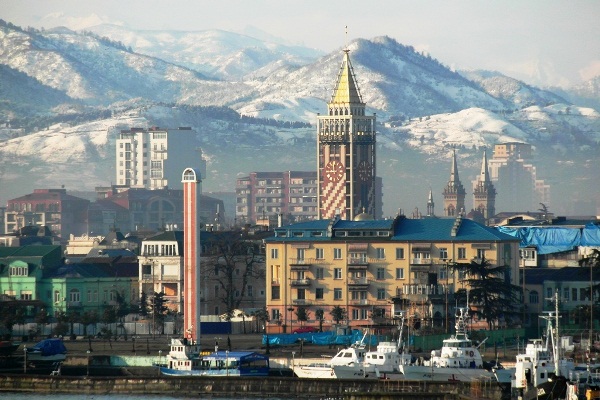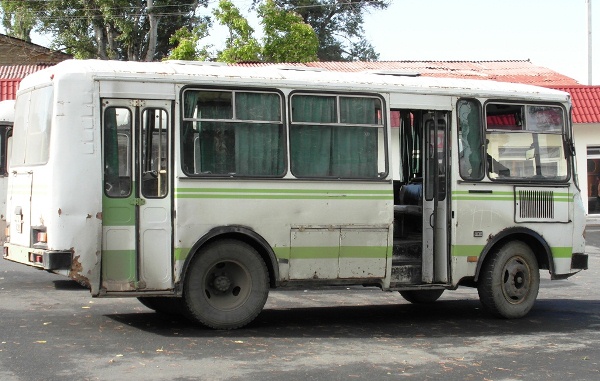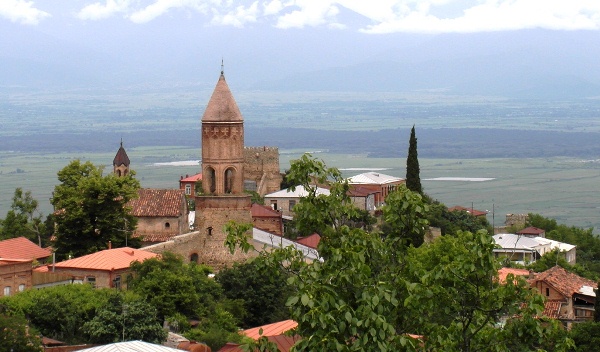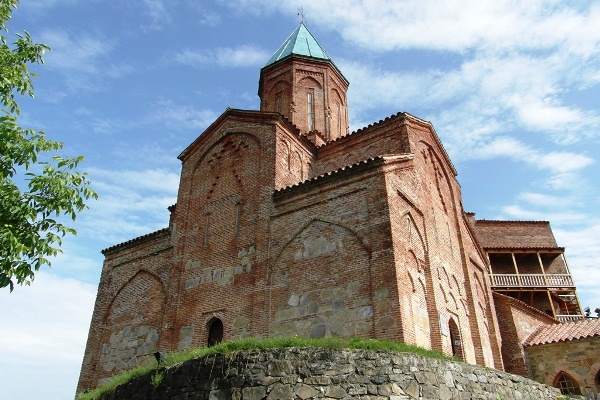
My first impression of travel in the Caucasus region was a good one, arriving in sunny Batumi, Georgia to a warm welcome from the immigration officers. One night later, I was on an overnight train, sharing a couple of bottles of cognac with three new Georgian friends. It was just a taste of what was to come as the people throughout Georgia, Armenia and Azerbaijan were some of the most welcoming I have met anywhere.
In addition to the people, these three Caucasus countries boast a wealth of ancient historical sites (some dating back to the 4th century!), beautiful mountain scenery and endless opportunities for adventure. I had nearly three months to explore all the Caucasus region has to offer (and I still left feeling like I could see and do more), but if you only have time to visit one country, which should it be?
Here’s my take on how they stack up:
1. People
Perhaps it is the benefit of lasting first impressions, but Georgians won me over early – I don’t know if the Armenians or Azeris stood a chance. From the guys who befriended me on the Black Sea Ferry to my drinking buddies on the train to Tbilisi, every Georgian I met seemed to be fun loving and helpful. Additionally, I never felt like anyone was trying to rip me off. The Azeris would have been a close second, but the helpfulness of strangers in Baku was offset by a creepy guy who propositioned me at a bus rest stop and the overall uncomfortable feeling I got from men staring at me constantly – it was one of the few things I disliked about Turkey and it felt the same in Azerbaijan.
Armenia may be at both an advantage and disadvantage because I spent so much more time there (six weeks altogether), which meant I saw more of the good and of the not-so-good. The people overall were friendly and welcoming, but I also ran into my fair share of taxi drivers and others trying to overcharge me.
Winner: Georgia

2. Prices
Armenia definitely comes out on top here. I could eat a good lunch for about $3, take a taxi anywhere in the city for less than $4 and even my marshrutka ride from Yerevan to Tbilisi was cheaper than going the other direction. Georgia comes in second, with a plethora of hostels to choose from in most major cities, cheap food and reasonably priced taxis for most day trips. Azerbaijan comes in a distant third. Prices in Baku were nearly at western European levels (not to mention I almost accidentally bought a pint of Baskin-Robbins for $25!). The country has few hostels and finding a hotel room for under $100 was difficult. Even homestays and guiding services outside of the capital are pricey compared to neighboring Georgia and Armenia. Add in the fact that for Americans a visa to Azerbaijan will set you back at least $140 and this is the least attractive country to visit in the Caucasus if you’re on a tight budget.
Winner: Armenia
Big loser: Azerbaijan

3. Getting Around
This could reasonably be a three-way tie as each country in the Caucasus has its own benefits and challenges.
In both Georgia and Armenia, the unfamiliar alphabets can make getting around a challenge – you can’t read the signs to tell where a given bus or marshrutka is headed. At least the Azeri language uses mostly a Latin alphabet. On the plus side, in the Georgian capital of Tbilisi, digital signs at the bus stops include the Latin alphabet translations of bus route destinations, making things a little easier. Likewise, announcements on the Tbilisi Metro are made in both English and Georgian while those on the Baku Metro are only in Azeri. The Metro in Yerevan might have been the most difficult as signs were only in Armenian and Russian and announcements only in Armenian.
When it comes to intercity transport, Azerbaijan seems slightly more organized than the others. The prevalence of buses in the country means there are schedules on which you can somewhat rely instead of the typical marshrutka that just leaves when full – although buses traveling between smaller towns tend to be decrepit Soviet-era buses (see below!).
The new bus station in Baku has clearly labeled bays for both buses and marshrutkas – it was heaven compared to the mass chaos that I found at Didube Bus Station in Tbilisi, where the only way to find the marshrutka you need is to wander around and ask. Likewise, transportation out of Yerevan is made more confusing by the fact that the bus station or parking lot from which a given marshrutka departs often changes without warning.
Winner: Despite the Soviet-era buses in some parts of the country, Azerbaijan

4. Tourist Infrastructure
Georgia’s government has made it a priority to improve the country’s image as a tourist destination and you can feel the effects throughout the country. From the brand new border control stations to rebuilt roads up to mountain villages, the investment is clear. Whereas a few years ago a trip to the region of Svaneti would require an overnight train ride from Tbilisi followed by a six hour drive up perilous mountain roads, the construction of a new, paved road has cut the time down to three hours.
Tourist information was also readily available in nearly every city I visited in Georgia – I stopped into tourist information offices in Tbilisi, Batumi, Mestia, and Mtskheta. In each I encountered friendly, English-speaking staff and was able to obtain a plethora of maps (the office in Mtskheta actually gave me maps for the Kakheti and Svaneti regions as well).
While the Azeri government made a big effort to welcome tourists to Baku for the recent Eurovision 2012 finals, from all indications they have largely ignored the rest of the country – one woman I met told me of roads in Baku being repaired 3 or 4 times while roads connecting major cities in the northwestern part of the country remain unpaved. On the other hand, Community Based Tourism Azerbaijan has stepped in to fill some of the void, providing a great network of homestays and helpful information for tourists traveling outside of Baku.
Armenia arguably lags behind on the tourism front, with the Visitor Information Center in the capital of Yerevan closing due to lack of funding a few years ago. I know firsthand from my experience volunteering with the de facto national tourism board that they are trying to make improvements, such as developing a new tourism website and a new information center, but it may take a while. To Armenia’s advantage, most of the major sites are easy day trips from Yerevan and local tour company Hyurservice runs multiple tours every day costing as little as $15. I took two of their day trips and thought they provided great value.
Winner: Georgia

5. Sightseeing and Activities
Of course, the big question is – what does each country have to offer in terms of sightseeing and activities?
Georgia and Armenia are very similar, with many, if not most, of their major sites focusing on the ancient history of Christianity in those countries. Armenia was the first country to adopt Christianity as its religion back in the 4th century and Georgia followed just thirty years later. This means that a majority of major sites are monasteries and churches, some of which are more interesting than others. Georgia additionally boasts a couple of cave monasteries built into the sides of cliffs and Armenia recently opened the world’s longest cable car taking tourists 5.7 kilometers across the Vorotan Gorge to Tatev Monastery.
In addition to its religious sites, Georgia has a burgeoning wine industry and a long history of wine-making, as well as an up and coming resort city in Batumi on the Black Sea coast. Add in the mountain regions and hiking opportunities in Svaneti and there seems to be a little bit of something for everyone.
Azerbaijan doesn’t have nearly the religious sites that its neighbors do, although a few ruined churches are scattered throughout the country. Not far from Baku are petroglyphs, quirky mud volcanoes, a so-called fire temple and the James Bond Oil Field (featured in the opening scenes of The World is Not Enough). For me, the main draw was the mountains and hiking opportunities in the northern and northwestern parts of the country, although those closest to the Russian border have recently been limited.
Winner: Georgia

6. Visa Requirements
I’ll just speak to U.S. citizens here, but you can generally enter Georgia visa free for up to 360 days. Visas to Armenia may be obtained upon arrival at the airport and land borders and cost about $8 for a 21 day visa or $35 for 120 days.
On the other end of the spectrum, a visa to Azerbaijan currently runs $140, plus the likely cost of a letter of invitation from an approved travel agency in Azerbaijan (I spent $160 altogether). And instead of making it easier for people to visit, the Azeri government has been making it harder. Not cool.
Winner: Georgia, with Armenia a close second.
Big loser (again): Azerbaijan
And the winner is…
If you hadn’t already guessed, I would say right now that Georgia is the place to go in the Caucasus – it is the easiest to visit, has the most developed tourist infrastructure, some of the friendliest people and the widest variety of sights and activities. At this point, it does not yet feel overrun with tourists, but get there fast as it likely won’t be long before the secret is out!
